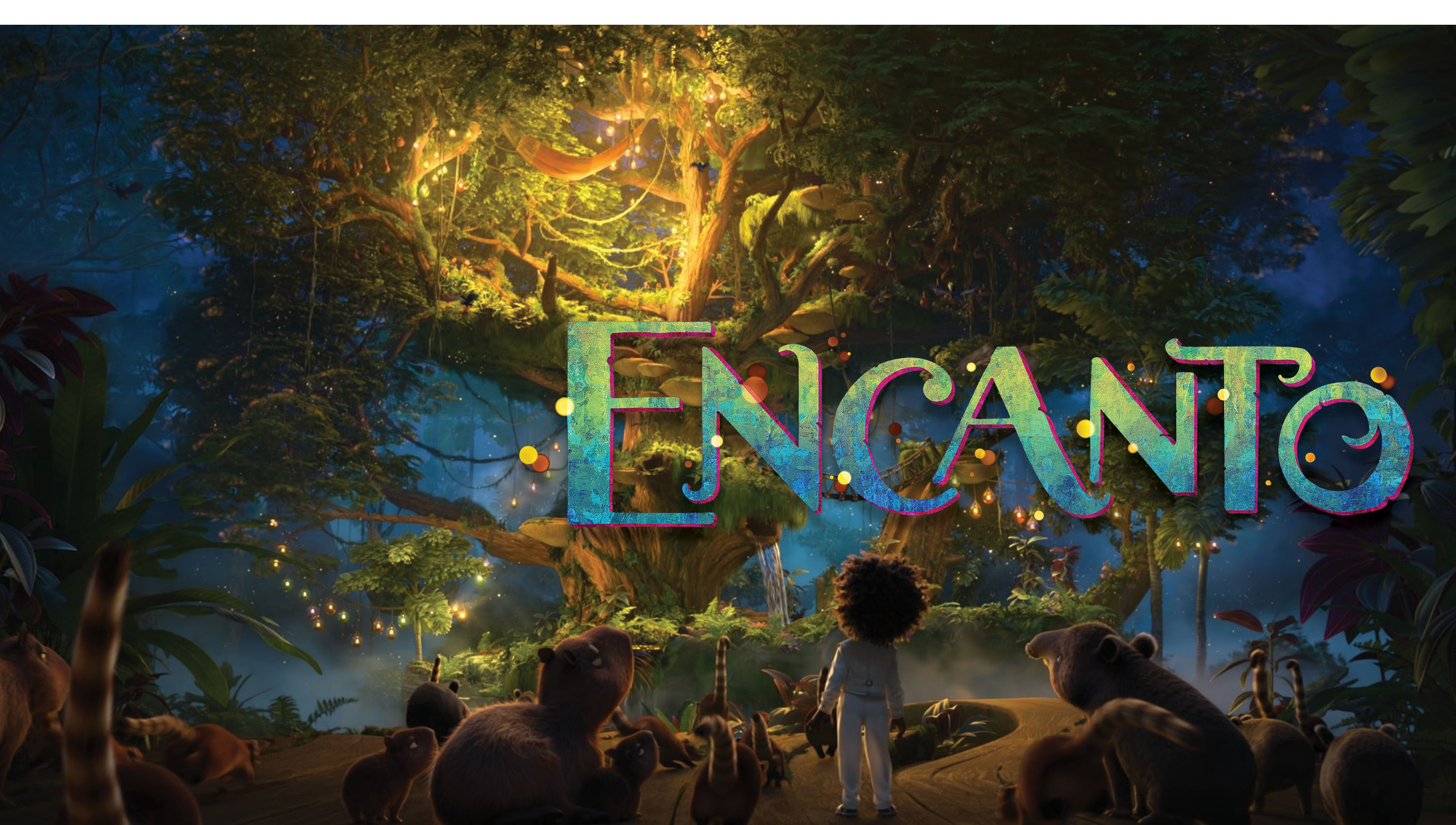We need to talk about Encanto (2021). Or, so says everyone on Twitter the last few weeks. Disney’s new animated film Encanto is a creative sensation that examines the complexities and importance of family. Though its plot seems to depart from its central message, the film presents a more culturally sensitive and elaborate interpretation of family that makes Encanto a must-see.
The film’s central characters are the Madrigal family, who live in an enchanted refuge nestled in a valley deep in Colombia’s tropical jungles. For the last 50 years, the village has existed under the protective magic of a continuously burning candle owned by Madrigal matriarch Alma (María Cecilia Botero); this same candle bestows “gifts”—interspecies communication, precognition, and so on—to Madrigal descendants. When it is time for Mirabel (Stephanie Beatriz), one of Alma’s granddaughters, to receive her gift, however, the candle’s flame dims, and she is left giftless. Shunned, Mirabel is left out of the family picture—and the candle flickers. The family’s toxic perfectionism overrides their relationships, threatening the longevity of their shared magic. In order to save her family’s miracle, Mirabel must stumble through her own journey investigating the family’s past, without any magical skills of her own.
While Disney has received backlash due to the studio’s lack of BIPOC representation, Encanto is a wonderful recognition of the racial and ethnic diversity within Colombia. In 2021, Disney’s In the Heights received complaints from viewers that the film primarily cast light-skinned Latino actors to play the leading roles, giving an inaccurate portrayal of the Washington Heights community as well as of the Latino community at-large. Disney made representation more of a priority for Encanto—the diversity of its characters paints a fuller picture of Colombia and sends a clearer message that there is no “one type” of Colombian.
The attention to detail found in this film creates a sense of generational and cultural consistency for the Madrigal family—reflecting the time and care that the creators spent crafting Encanto. The family spans three generations, and the designers implemented a color scheme to visually distinguish between members of the expansive household. Characters are adorned in cool tones from rich purples to calming blues, and warmer palettes of vivid reds and festive yellows. In addition to details about the family’s clothing, the creators make culturally thoughtful choices about the application of the family’s gifts. For instance, Mirabel’s mother (Angie Cepeda) has the power to heal people with her food—and traditional Colombian dishes like arepas and buñuelos serve as her remedies. These details not only draw connections between members of the Madrigal family but also emphasize the context in which the movie takes place.
Similar care and attention is given to the symbolic elements of the film’s soundtrack, written by Lin-Manuel Miranda. Miranda noted that he incorporated Mirabel’s feelings of isolation into her solo song “Waiting on a Miracle” by making it rhythmically distinct with a beat of three. It’s a smart choice, as Mirabel is also emotionally on a separate beat from her family. Encanto’s soundtrack encompasses Miranda’s typical layering of upbeat melodies, but that doesn’t make it any less impressive. His distinct musical ability shines through as he establishes distinct melodies and voices for each character and blends them all together to create a harmonious musical climax, emblematic of the Madrigal family. Miranda highlights this technique through the wildly popular “We Don’t Talk About Bruno,” expertly weaving distinctive vocal personalities.
“Dos Oruguitas,” however, provides the audience with a moment of pause from the fun and catchy tunes of previous songs as Abuela Alma reflects on her past. Beautifully sung in Spanish, it boasts a sentimental melody and is overlaid over a particularly tender narrative, meaning even audiences who don’t know Spanish can intuit the underlying mood. The bittersweet essence of “Dos Oruguitas” serves as a contrast to the other songs in Encanto and enables us to empathize with Abuela Alma and her experiences.
Encanto represents a new direction for Disney, with a focus more on character development and less on a Manichaean battle between good and evil. Families are complicated, people make mistakes despite their love for each other, and Disney’s decision to not have an explicit villain in Encanto demonstrates this intricacy. Each character’s complexity brings them to life and allows audience members to see individual struggles and triumphs as a point of contact. Viewers understand the unique pressures each one experiences. Older siblings can relate to Luisa’s (Jessica Darrow) urge to be the person her family always relies on while paving the way for her younger family members. Audiences can find solace with Pepa (Carolina Gaitan) if they have ever felt the demand to conceal their feelings and consistently be happy. While the Madrigal family’s gifts are magical, their struggles are frighteningly real.
With a large ensemble cast and only about 90 minutes of screen time, it is difficult to fully invest in all of the relationships between the members of the Madrigal family. Early in the film, audiences briefly see the caring bond between the two youngest grandchildren, Mirabel and Antonio (Ravi Cabot-Conyers), and Antonio even asks Mirabel to accompany him as he receives his gift. After this moment, however, the relationship between Mirabel and Antonio gets little airtime, making it feel underdeveloped.
Disney tackles the theme of family in a new way, but the ending could have more closely reflected its overarching message that everyone has an innate talent that they can share with others. Though the film ends with the Madrigal family marked by a new closeness as they construct their new home together, it is difficult to tell if the importance of the candle has changed for the family from the beginning of the movie until the end. Where the movie should have ended is an assertion that the true gifts we have are found inside of us, not bestowed externally, and that the Madrigals’ unity as a family is not dictated by the magic they possess. This message, unfortunately, gets lost amid the spectacle of the return of the magic.
The creators of Encanto wanted to accentuate the idea of family, and their efforts are evident throughout the film. Through characters’ honest revelations, the audience can find resemblances between themselves and these multidimensional characters, creating a desire to be invested in the journey of these characters. With family being such an integral aspect of Encanto, the ending could have coincided with the growth each character experiences and better supported the idea that magic is not what binds the family together—their love for one another does. Nevertheless, Encanto’s authentic handling of culture and complex familial relationships combined with its electrifying musical flair make this film an instant Disney classic.





